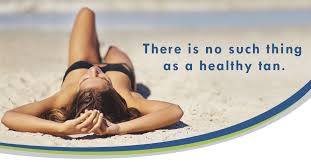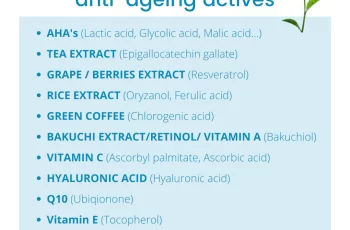Here’s Why There Is No Such Thing As A ‘Healthy’ Tan
Sunkissed skin may be aesthetically pleasing, but we’re here to tell you there is no such thing as a healthy tan, and your bronzed glow is quite literally a sign of skin cells in trauma.
*Viciously applies sunscreen to all exposed areas.
**^Good! So you should! Daily!
Before you double down on your vitamin d obsessed bestie, arm yourself with the cold, hard facts. And to save you the effort of surfing the web, we picked the brains of Dr Annika Smith, Consultant Dermatologist at The Skin Hospital Darlinghurst.
“Put simply, tanning is a sign of distressed skin and (irreversible) DNA damage. It’s actually the skin’s response to damage from the sun’s ultraviolet radiation. Our skin cells try to prevent further injury by producing melanin – a substance which gives skin its colour and causes darkening” explains Dr Smith.
This damage is cumulative and starts from your very first tan, incidental or otherwise. Each time you seek/experience a tan, the damage builds, you’re creating more genetic mutations, and fundamentally increasing your risk of developing skin cancer.
Appropriately dumped in the basket of life choices labelled ‘short term decisions with long term consequences’ (next to not brushing your teeth, and having musk sticks for breakfast), Dr Smith notes the short term effects of skin discomfort and sunburn experienced enroute to tanning, while further down the track you can expect ‘premature ageing of the skin (wrinkles, pigmentation) and the development of skin cancer’, which we know to be life threatening.
Australians have a pretty solid understanding of the dangers of the sun, given ours is so bitey, like, all year round, but we still have a long way to go. One Australian dies from melanoma every six hours, one Australian is diagnosed with melanoma every 30 minutes, and, it remains the most common cancer for Australians aged 20 to 39.
On the very off chance you simply couldn’t avoid the sun during peak UV periods, and perhaps didn’t quite nail that first round of sunscreen application, here’s what to do post sun: “Hydrate, steer clear of any further sun exposure, and keep your skincare simple. Moisturise, avoid actives that might dry or irritate the skin, and stick to lightweight formulations with ingredients that will calm and soothe. And most importantly, make sun protection part of your everyday skincare routine”.
To give yourself the best chance of protection, you have to tick all the boxes, not just a few. We’re talking SPF 50+ broad spectrum sunscreen, wearing a hat, clothing, sunglasses, seeking shade and avoiding sun in the middle of the day. “Sun protection can actually prevent the majority of skin cancers and at the end of the day, prevention is better than cure” states Dr Smith.
As expected, Dr Smith recommended everyone establish their risk profile with a GP or dermatologist when it comes to skin cancer, and set up a skin check regime that is right for you. “Get to know your skin and be on the lookout for anything new or changing as early detection offers the best chance of cure.” Look for freckles and moles that change in size, shape or colour. That spot that stands out from the rest – the ugly duckling – may be a clue to melanoma too.
Adequately spooked? Sorry (not sorry). We’re not (SP)F’ing around when it comes to skin health.
DQH Knowledge drop: In your 20s, your skin cell turnover decreases. (Cell turnover is a key component in keeping your skin youthful.) You know what else slows down? Your collagen production. Starting in your 20s, collagen decreases by about 1 percent per year. Should you want to prevent fine lines and wrinkles, start by eliminating behaviors that contribute to premature aging. “If it’s bad for you, it’s bad for your skin,” says dermatologist Michel Somenek.
“Cigarette smoking reduces blood flow to the skin and causes premature wrinkling and a dull skin texture. Making the repeated pursed motion to inhale can also cause smoker’s lines. Alcohol and recreational drugs are toxins for the skin that damage its cellular structure and DNA,” Somenek tells us. “The faster you eliminate vices while you are young, the better chance your skin and body have to recuperate.” Also, adopting an anti-aging routine in your 20s is key. After all, the best offense is a good defense. We spoke to Somenek and experts Joshua Ross and Audrey Kunin to find out more.
Keep reading for the best anti-aging products for your 20s, according to skincare professionals.
Sunscreen
“We all know that the sun is the number one cause of skin aging and starting the prevention in your 20s is very important,” Ross says. “The majority of your sun damage won’t start to appear until you’re in your 30s, so don’t wait until you see it surface or you’ll be behind the curve. Stay ahead of it with a good-quality zinc-based sunscreen worn daily.”
Farmacy Green Defense Daily Mineral Sunscreen
An invisible sunscreen with SPF 30, plus botanical extracts meant to protect skin with tons of antioxidants. Bonus: It’s clean and fine to use under makeup.
Bareminerals Complexion Rescue™ Tinted Moisturizer Broad Spectrum SPF 30
Although we recommend you use your SPF and moisturizer separately, we also understand moments when you don’t have time or energy for that extra step. For those times, this bareMinerals moisturizer is a great thing to have on hand.
Vitamin C Serum
“A great introduction to anti-aging is to start with a vitamin C serum in your morning skincare routine,” Ross says. “It’s a powerful antioxidant that will neutralize free radicals and brighten the skin.” He adds that it’s a great way to counteract the effects of the sun’s harmful rays, which, as previously mentioned, are among the biggest causes of premature aging.
Drunk Elephant C-Firma™ Vitamin C Day Serum
The Drunk Elephant C-Firma is a lightweight serum that promises to give skin a glow by combining the brightening powers of vitamin C with ferulic acid, l-ascorbic acid, and vitamin E. The included sodium hyaluronate is meant to replace hydration loss, so you shouldn’t have to deal with any irritation.
Sunday Riley C.E.O. Rapid Flash Brightening Serum
This potent serum is jam-packed with vitamin C (15 percent, to be exact), which means it’s a potential superstar at both brightening skin and dousing it in antioxidants.
Peptides
Using peptides on your skin has many benefits, says Somenek. “The skin barrier is what defends the body against pollution, UV rays, bacteria, and toxins. It can be damaged by several everyday factors. Using topical peptides aids in building a stronger barrier,” he says. “Peptides comprise elastic fibers, which are a type of protein. These fibers help to make skin appear taut and firm. Peptides can also help repair damaged skin, relieve inflammation, and even out skin tone. Some peptides can kill acne-causing bacteria that is common in 20-somethings.”
Kunin agrees, saying, “Peptides are an excellent entry point for supporting collagen.” She recommends looking for face and eye treatments that contain these collagen-boosting powerhouses.
Charlotte Tilbury Magic Eye Rescue Cream
This Charlotte Tilbury super-emollient eye cream has a base of coconut oil and shea butter (read: it’s incredibly hydrating). Botanicals plus peptides are meant to help reduce dark circles and boost collagen, respectively.
This creamy moisturizer serves up potent collagen-boosting peptides and pycnogenol, and antioxidant-rich vitamin C. “Instead of sitting on top of the skin, peptides penetrate the outer layer so they go deep. The ‘signals’ they send tell the cells to produce elastin and collagen, which are needed for youthful-looking skin,” explains Somenek.
At-Home Peel Pads
Remember that skin cell turnover fiasco we talked about earlier? One way to help support it is by exfoliating. “Exfoliation is important to help keep skin fresh and luminous,” Kunin says. She recommends using at-home peel pads as an easy and effective way to exfoliate.
“The goal in your 20s is to fight the slowing pace of cell turnover. It is wise to use products that gently exfoliate, yet still remove oil and other impurities. Products that have Alpha Hydroxy Acids (AHA) or Beta Hydroxy Acids (BHA) are a good choice.”
According to Somenek, you should only exfoliate two to three times a week. “People of all ages are guilty of over-exfoliating and that can be too much of a good thing,” he says.
Dermadoctor Kakadu C Intensive Vitamin C Peel Pad
A few swipes of this Derma Doctor powerful peel pad promise to leave your skin glowing and smooth, thanks to the seven (yes, seven) types of chemical exfoliants, including AHA and BHA. It also contains vitamin C via Kakadu plum extract for added brightening and antioxidant protection.
KEY INGREDIENTS Kakadu plum extract is sourced from the Kakadu plum, a fruit grown in northern Australia. It contains vitamin C, which restores the skin’s natural barrier, increases collagen production, and soothes irritation.
Dr. Dennis Gross Skincare Alpha Beta® Universal Daily Peel Pads
These are the gold standard of peel pads, with a cult following and over 900 five-star reviews on Sephora. They’re easy to use and contain a blend of anti-aging exfoliating acids.
Emollient Night Cream
“In your 20s, you need to start upping the hydration in your skincare routine. You may have been cautious of over-moisturizing because of acne in your teens, but as you enter your 20s, your skin transitions and becomes drier,” Ross says. “I recommend an emollient night cream added into your evening skincare regimen.”
“Twenty-somethings need to make sure that they are not using creams that will clog their pores and cause excess oil production,” says Somenek. Opt for non-comedogenic products.
Cerave Skin Renewing Night Cream
One great choice is the CeraVe Skin Renewing Night Cream, which is a non-comedogenic night cream that leaves skin soft and glowy. It combines the moisturizing powers of ceramides and hyaluronic acid.
RoC Retinol Correxion Max Hydration Creme
“The best night cream ingredients contain retinol, benzoyl peroxide, and/or salicylic acid or hyaluronic acid. The goal is to moisturize, yet remove excess oil,” says Somenek. This Roc Retinol Correxion cream fits the bill as it contains both hyaluronic acid and retinol so it promises to moisturize while also being non-comedogenic.



